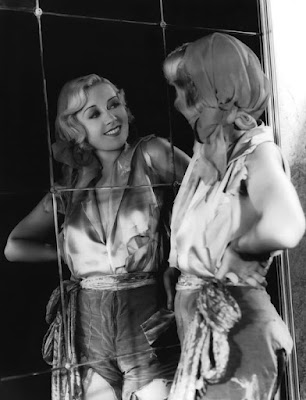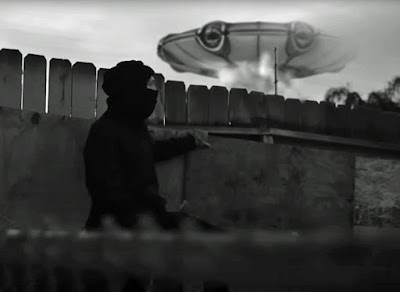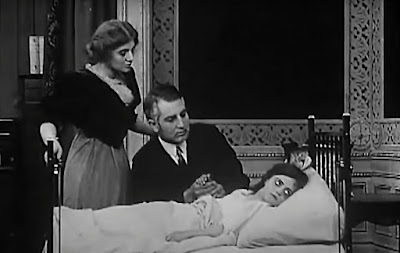Writers: Richard Sala and Tom De Haven
Artist: Richard Sala
With "The Peculiar Case of Dr. V", Sala presents a mystery tale that features his trademark mix of suspense and goofiness, blended with a twist ending that elevates the take from average Sala to excellent Sala. It's another 7-Star effort!
"Black Cat Crossing" is a spectacular collection of Richard Sala's early work, which remains as fresh and exciting as it was when it was first created three decades ago. That shouldn't be surprising, since he drew his inspiration from pop-culture and artistic evergreens.
Rating: Eight of Ten Stars
"Black Cat Crossing" collects 17 short stories done by Richard Sala during from the mid-1980s through the early 1990s. There are also a pair of Sala's intrigue- and mystery-drenched "pin-up pages" that serve as endpapers for the book, a table of contents that is executed in the style of an illuminated manuscript; and another Sala's activity-packed one-pagers serving as a frontis-piece. So, it's like we're being treated to a few opening acts before the main event!
"Black Cat Crossing" collects 17 short stories done by Richard Sala during from the mid-1980s through the early 1990s. There are also a pair of Sala's intrigue- and mystery-drenched "pin-up pages" that serve as endpapers for the book, a table of contents that is executed in the style of an illuminated manuscript; and another Sala's activity-packed one-pagers serving as a frontis-piece. So, it's like we're being treated to a few opening acts before the main event!
Many of the stories had previously appeared in comics anthologies (which were, sadly, dying out once and for all during the period Sala was contributing to them), and a few were original to this book. Most are examples of Sala's ability to capture the feel of randomness that permeated many pulp short stories of the 1930s while crossing them with a 1940s and 1950s B-movie or film noir sensibility. A few also shows how he can masterfully he can use the "unreliable narrator" in his stories.
The rating I give this book is an average of the stories within it.
The collection opens with three long stories (each more than ten pages). The first two, "The Fellowship of the Creeping Cat" and "The Big Dark Zero" feature equal parts mystery, drama, and humor. They are loving spoofs of pulp-fiction and film noir mystery tales with ludicrous set-ups and overly tangled dark secrets that nonetheless are executed every bit as serious as "The Maltese Falcon". And this is why they work. Both stories also sport genre-appropriate endings that are a satisfying mix of tragic and justice that will leave even the most critical reader satisfied.
"The Fellowship of the Black Cat" focuses a writer of limited success who finds himself at the center of a string of murders related to a long-defunct secret society of vigilantes. It is full of goofy elements, but it is also features escalating tension, because the reader clues into the trouble the protagonist is getting himself into before he does. The mystery of who is behind the plot is also an interesting one. The only complaint I have about the story is that the ending could have been a little stronger, so it rates an 8 of 10 Stars.
"The Big Dark Zero" is a pulp-fiction, film-noir style mystery tale about an amnesiac who has to rediscover his forgotten past to discover why people are suddenly trying to kill him. As the mystery unravels, the facts become increasingly ridiculous, but the story is played perfectly straight throughout, with even a touch of tragedy, which makes this a very effective tale. This is a solid 9 of 10 Stars.
The third and final of the longish stories in "Black Cat Crossing" is also one of the very best in the book. It may even be the best short story Sala wrote and illustrated, period. (It also has an amusing bit of crossover with another story in the book, perhaps the earliest example of the Salaverse, which is hinted at in some of the Peculia and Bloody Cardinal stories, and elsewhere.)
"Where is Christine Broder?" is one of the finest examples of how Richard Sala was an expert of the unreliable narrator. Throughout this whole film-noirish mystery tale involving a burned-out investigator looking for a missing woman the reader has the sense that something is off. It's a sense that keeps growing, but you're never quite sure WHAT is off about the first person narrative that's unfolding and when Sala finally reveals the truth of what's going on, in a perfectly timed and executed fashion, readers feel a mixture of empathy for the narrator and a twinge of horror about his situation. It's a 10 of 10 Stars without question.
In the middle of the book are six one- and two-page stories in color. They are generally the weakest of what is collected in this volume, with four of them feeling more like story sketches or outlines than full-fledged works; I give most of these collective 6 of 10. The only two that are worth commenting on are a chilling spoof of romance comics titled "A Newlywed's Heartache" (in which the bride discovers chilling facts about her husband) and "Night Delivery which is a pun-based one-page story that I probably found more amusing than any adult should. Both of those rate 8 of 10 Stars.
The black-and-white stories resume with "Another Mad Doktor", which you can read in its entirety, here at Shades of Gray; and "Psychorama", which is the earliest of at least three spoofs of the kids' "alphabet primers" that Sala did. Each letter of the alphabet stands for a deadly lunatic in a psychologist's casebook, and each of these one-panel, rhyming gags are a mixture of cute and creepy. Both of these earn a solid 8 out of 10 Stars.
Next up, we have "The Proxy", a story drawn by Sala but written by . I'm not sure what to make of this one. I read it four times, carefully, and I am still not certain what's going on or what the point it. I am not even sure if there is a point, beyond telling a story about a guy who is is drawn back into the web of deceit and lies and manipulations that exists around his shady kinda-sorta friend, Doc. By the end of the story, I had the sense that the protagonist is screwed and that Doc... well, I really don't know about Doc. Still, it was an engaging story, so it's getting a 7 of 10 Stars.
Next up, we have "The Proxy", a story drawn by Sala but written by . I'm not sure what to make of this one. I read it four times, carefully, and I am still not certain what's going on or what the point it. I am not even sure if there is a point, beyond telling a story about a guy who is is drawn back into the web of deceit and lies and manipulations that exists around his shady kinda-sorta friend, Doc. By the end of the story, I had the sense that the protagonist is screwed and that Doc... well, I really don't know about Doc. Still, it was an engaging story, so it's getting a 7 of 10 Stars.
With "The Peculiar Case of Dr. V", Sala presents a mystery tale that features his trademark mix of suspense and goofiness, blended with a twist ending that elevates the take from average Sala to excellent Sala. It's another 7-Star effort!
Next is one of the weaker efforts in the book, "Hypnorama", which is a comics summary/dramatization of a tell-all book about how subliminal messages were/are concealed in advertising art and logos. While Sala did a good job of both summarizing the topic of the book and infusing his adaptation with a sense of insanity, it just didn't grab me. Maybe it's because I am already very familiar with the topic, or because it's been done to death over the 35 or so years that have passed since Sala delivered his take on it? Whatever the reason, this one gets 6 of 10 Stars.
The last story in the book, "Judy Drood, Girl Detective", is a Sala milestone. It marked the first appearance of one of Sala's signature characters, Judy Drood. Over the space of two pages, Sala delivers a fun spoof of classic kid/young adult adventure fiction (specifically the novels starring teenaged amateur detective Nancy Drew) as well as bringing us a great example of his ability to tell complete stories in single panels--or, even better, feed the readers' imaginations with summaries of great stories . All-in-all, it's clear why this, which was initially conceived as a one-off by Sala ws something that his friends encouraged him to expand into something bigger. This tale is a solid 10 of 10 Stars, and it's another one of those that you can read here at the Shades of Gray blog.
Rounding out the anthology is the expected author's bio--although Sala delivers one that is not at all one would expect... and in perfect keeping with his forever tongue-in-cheek approach to his storytelling, one final single panel cartoon, and another of his one-page pin-up style pictures--the endpaper I mentioned at the top. These all get a solid 8 of 10 ratings.
"Black Cat Crossing" is a spectacular collection of Richard Sala's early work, which remains as fresh and exciting as it was when it was first created three decades ago. That shouldn't be surprising, since he drew his inspiration from pop-culture and artistic evergreens.
When I average out the ratings, this anthology is a solid Eight of Ten Stars... and one that I think is well worth checking out by anyone who enjoys well done comics, film-noir, silent movies, and mystery fiction. I think you'll have a great time while in the Salaverse. (It's still in print, but it's impossible to say for how long. Sala is rapidly joining the ranks for unjustly forgotten comics creators.)












































.jpg)
